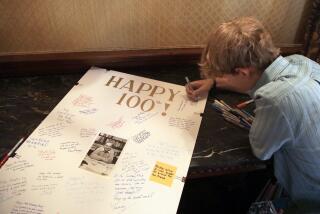Pushed by Curiosity and Poor Eyesight
- Share via
“If we were evolved a little further so we could see 10 times more sensitively, we wouldn’t have to have this discussion,” Richard Feynman explains in the first series of Alix G. Mauntner Memorial lectures delivered at UCLA. Feynman, a Nobel Prize winner in physics, has spent much of his scientific life making sense of the interactions between very small particles that none of us can see, such as electrons and photons, which are the substructure of the universe.
Exactly 300 years ago the French scientist Bernard le Bovier de Fontenelle expressed a similar idea. “All philosophy is based on two things alone, curiosity or poor eyesight, because if we had better eyesight we could see whether or not stars are suns which light their worlds, and if we were less curious, we wouldn’t care. The trouble is, we want to know more than we can see.”
Much of the history of science has been an attempt to understand what we cannot see and to develop instruments that enable us to see the microscopic as well as the macroscopic universe.
In our time Feynman has contributed a great deal toward making sense out of what is still unseen, and as a teacher, he has stimulated others to improve the technology that gives us access to the microscopic world. In “QED: The Strange Theory of Light and Matter” (Princeton University Press) we join the audience as Feynman asks us to accept the fact that the behavior of particles of light is against common sense. From the point of view of common sense, he tells us, nature is absurd, but the “absurd” agrees fully with experiment.
This very slim volume is easy to read but not necessarily easy to understand. Feynman never forgets, as he moves from one lecture to the next, that his audience is probably far behind him. Those of us who will not qualify for post-doctoral research when we have finished will nevertheless feel pleased that we have understood something about the nature of how some of those particles many times smaller than we can see with the naked eye are interacting with each other.
Twenty-six years ago, fascinated with the prospect of operating at the level of electrons, if not photons of light, Feynman offered a $1,000 prize to anyone who could reduce the text of a “page of a book in an area 1/25,000 smaller in linear scale in such manner that it can be read by an electron microscope.”
The challenge, nicknamed “Plenty of Room at the Bottom” after the original 1960 lecture during which he made the offer, was printed in Caltech’s Engineering & Science magazine in February, 1960.
Nothing happened for several years, but the challenge was mentioned from time to time at research institutions, including Palo Alto, where it came to the attention of Tom Newman, a graduate student in electrical engineering. Newman was moved as much by the problem itself as by the money (which had dwindled somewhat in value from its worth in 1960).
Newman’s doctoral work involved electron beam lithography, a process used to “write” on the very small chips of electronic devices. Newman was experimenting using a multi-beam approach. He needed a good demonstration pattern and decided that Feynman’s challenge met his needs. He selected the first page from “A Tale of Two Cities”--one of his favorite books--that happened to be the right size.
He used a beam of electrons about one five-millionth of an inch in diameter to scan the text across a plastic membrane. And like the ordinary lithographer, he etched away the exposed regions with a chemical solvent. Etching in the entire first page took Newman about a month. When he finished, he wired Feynman to see if the prize was still available. He claimed it, and his doctorate, in December, 1985.
Feynman is as delighted as Newman. He notes that each of Newman’s dots (the print is in dot matrix) is only about 60 electrons on a side. At this size, the entire Encyclopaedia Britannica could fit onto the head of a pin.
Feynman was prescient in 1960 when he suggested that the miniaturization of writing was within reach. In the decades since then we have, indeed, miniaturized a great deal of information, and the time is not too distant, he says, when all the books in the world could comfortably be fitted into a space about three square yards.






